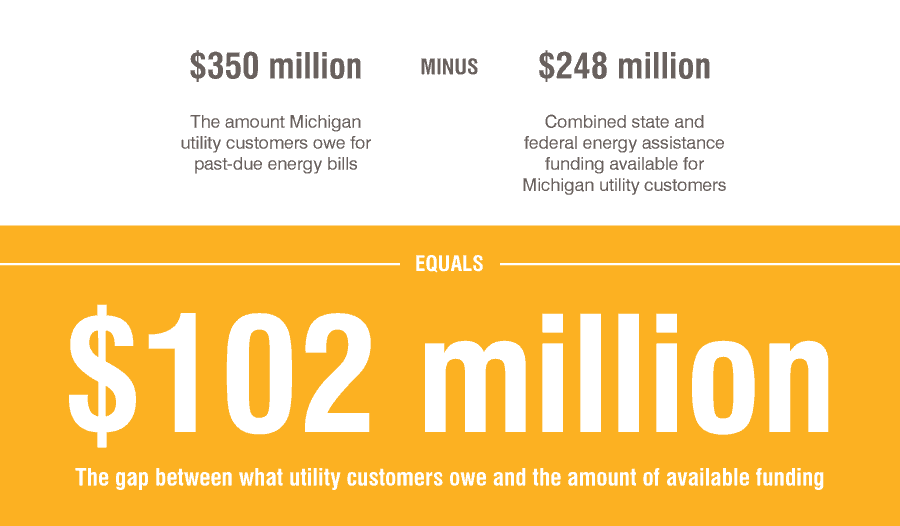This is the first in a three-part series taking a look at the utility cliff looming ahead for many Michiganders and the state and federal assistance available to keep them from falling over the edge.
The coronavirus (COVID-19) pandemic and subsequent measures taken to protect public health dramatically slowed Michigan’s economy, resulting in dire financial circumstances for many households in the state. The closure of all nonessential businesses starting in March contributed to more than 800,000 new unemployment claims through April 2020. The closure of offices, schools and daycares has meant more people are home and consuming greater amounts of energy than usual. For those facing job loss or reduced work coupled with higher energy use, the ability to afford utility bills adds to the stress.
Three weeks after Gov. Gretchen Whitmer issued the Stay Home, Stay Safe executive order, the Michigan Public Service Commission (MPSC) issued Order Number U-20757, outlining protections for consumers, including a moratorium on service shutoffs. While this order ensured customers would not have their services disconnected while under the governor’s order to stay home, the moratorium expired on June 12. Customers behind on their utility bills now face the prospect of paying their past-due balances or being disconnected just as summer starts.
With these cases stacking up and energy usage rising, we have to ask: how many people grappling with the financial upheaval caused by COVID-19 will have utility bills come due that they can’t pay? And what is Michigan doing to help?
1.3 million
The number of gas and electric utility accounts in the state with bills more than 30 days past due, as reported to the MPSC through June 5, 2020. This likely understates the true extent of the issues, as these figures do not include customers for most electric cooperatives and municipal utilities or customers who rely on deliverable fuels, such as propane.
951,809
The number of Michigan households below 150% of the Federal Poverty Level, the threshold for determining eligibility for state and federal energy assistance funding.
>6%
The percentage of income a household must spend on home energy costs to be considered “energy poor.” This threshold is often used for comparison purposes and to estimate the affordability gap, which measures the difference between a household’s actual energy bills and an affordable energy bill.
3x
Low-income households spend an average of three times more of their household income on energy bills versus higher-income households, despite consuming less energy per capita. The energy burden is regressive, with the financial impact increasing as household income declines.
3/10
The number of families that would be unable to pay their monthly bills or are one modest financial setback away from failing to pay their monthly bills as indicated by the Federal Reserve’s Survey of Household Economics and Decisionmaking. Even fewer adults had enough savings to cover expenses in case of a job loss lasting three months.
19.1%
The two-month increase in Michigan’s unemployment rate between February and April 2020, which catapulted the state to an estimated unemployment rate of 22.7%. “These job losses were most severe among workers with lower incomes. Thirty-nine percent of people working in February with a household income below $40,000 reported a job loss in March” (Federal Reserve May 2020).

$350 million
The amount owed by Michigan utility customers for past-due energy bills as of June 4, 2020.[1] The MPSC required regulated gas and electric utilities to report this information as part of the State’s ongoing monitoring of the response to COVID-19 and its impact on customers.
$248 million
The combined state and federal energy assistance funding available for Michigan customers in the 2020 fiscal year. Michigan recently received $35.1 million from a one-time supplemental appropriation to the federal Low Income Home Energy Assistance Program (LIHEAP) from the Coronavirus Aid, Relief, and Economic Security (CARES) Act. On top of Michigan’s share of federal LIHEAP grant dollars, the Michigan Energy Assistance Program raises $50 million annually from a surcharge on electric bills for customers of participating utilities.
Now what?
Unfortunately, there are no surprises here.
Energy affordability has been a long-time challenge for many Michigan residents, but annual state and federal energy assistance options mostly maintain an inadequate system.
Despite the deficiency, it’s possible to examine the efforts of the past when seeking solutions for the future. Drastic action was taken to combat the energy affordability issue following the 2008 financial crisis, when Michiganders were facing similar problems to those challenging them now. Policymakers found solutions in energy efficiency, which helped to decrease unnecessarily large utility bills over time. Supporting this move, the U.S. Congress more than doubled the amount of funding for LIHEAP and — most importantly — appropriated an extra $5 billion to the Weatherization Assistance Program (WAP), which helps fund energy-efficiency improvements for low-income households. However, last year, Michigan spent just 3% of its annual LIHEAP budget on the WAP, the fourth-lowest investment nationwide.
Broad, decisive actions like investing more in energy-efficiency improvements can positively impact affordability, but with the scale of the problem, they’re only a patch. Bringing the focus around to repairing the system that leaves many in financial jeopardy could save Michiganders from toppling over the edge of the utility cliff.
[1] This does not include customers for most electric cooperatives or municipal utilities or customers who rely on deliverable fuels, such as propane.


